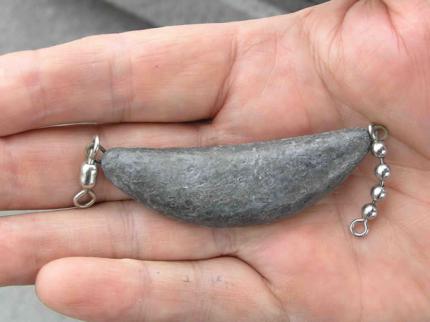
The most popular boat fishing methods can be lumped into two general categories, drift fishing and trolling.
Drift fishing
Drift fishing generally means fishing without a motor, although in some cases a small outboard may be used to slow down or speed up your drift. Drift fishing is most effective in specific areas where salmon are concentrated. Types of drift fishing include mooching, jigging, and fly-fishing.
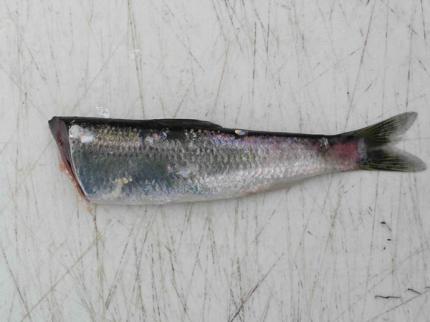
Mooching
Historically mooching was the most popular form of salmon angling and began many years ago during the winter months in Seattle. The art of mooching is slowly being lost as most modern anglers prefer to troll. Die-hard moochers like the simplicity of the gear, the feel of the bite and the hook up, and enjoy the peace and quiet of fishing without a motor. Mooching requires a dedication to the sport and many years of practice to master.
Mooching is essentially fishing with a light banana shaped weight (Photo 1) to pull a hooked herring down to the depth you believe the fish are at. Most moochers use a “plug-cut” herring (Photo 2) which spins as it rises and falls. A plug cut herring is cut with a bevel from front to back and from side to side.
The bevel is what causes the herring to spin as it is pulled through the water. Beginning moochers should probably purchase a miter box cutter to ensure the proper angle is obtained (Photo 3). Moochers will typically fish with an 8 ½ to 9 foot rod with a level wind or bait casting reel capable of holding 100-200 yards of line (Photo 4).
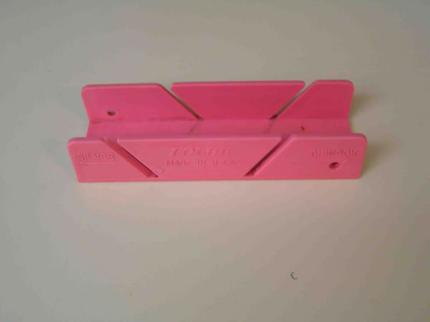
A reel that can be put into direct drive works best for mooching, as the bait can be lowered by simply letting go of the handle while holding your thumb lightly against the spool and allowing line to peel out, or raised by reeling in. However, finding a direct drive reel is getting harder each year. You might have to look for a used one. A standard level wind reel will also work. Moochers will generally use a main line of 10-20 pounds, and leaders of 8-15 pounds. Leaders can be tied with either 1 or 2 hooks (Photo 5), and there are many ways to attach the herring to the hooks (Photo 6). You should match your hook size to the size of herring you are fishing. For example, a 4/0 hook closest to the rod and a 3/0 hook away from the rod match up well with “green pack” (5-6”) herring.
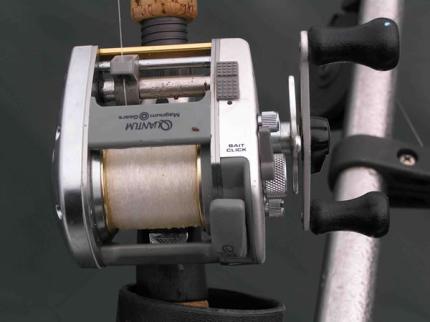
Moochers raise and lower the bait in the water column using their rod and reel, causing it to spin, or they simply allow the movement of the boat and waves to impart an action on the bait. When mooching, you should attempt to keep your line angle at 45 degrees. You can change the line angle by using a lighter or heavier weight. If the line angle gets near vertical, the leader will tend to wrap around the mainline, leaving a nasty tangle and an ineffective bait. If the current is moving very fast, the angler can use their boat motor to “back” into the current until they achieve the 45-degree angle. Conversely, if the current is moving very slow, you can move forward in spurts until the correct angle is achieved. You can approach mooching a couple of different ways. Some anglers will work the entire water column, letting the bait down say 10 feet, reeling up 3 or 4, letting down another 10, reeling up 3 or 4, etc. until they have reached the bottom. You can then start over again, or work the bait back up through the water column in the same manner. Other moochers prefer to fish at a particular depth. They let their line out until they are at the depth they wish, then work the bait up down at that depth, or let the wave and boat action work the bait up and down.
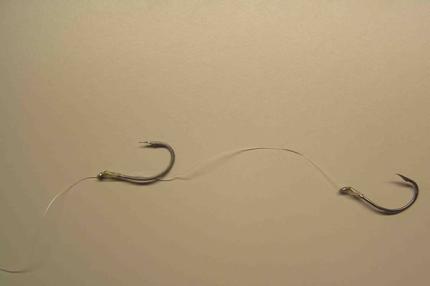
Jigging
Another popular method of drift fishing is jigging. When jigging, anglers use a fish-shaped, lead jig (Photo 7) that they move up and down with sweeps of their rod. A shorter, stiffer rod works better for jigging. For example, a 7 ½ foot rod rated for 4 or 6 ounce lures is a great choice. As with the moochers, a direct drive level wind reel is ideal for jigging. The newer “Spectra” based lines are the best to use for jigging. These lines have very little stretch and allow you to feel every little tap on your jig. Use 10-20# line for your mainline. When fishing at depths greater than 100’, the Spectra lines are almost a necessity. You may want to use a 3-4’ monofilament leader when jigging. Jigs can cause a lot of line twist. So use a good quality swivel between your mainline and leader to prevent line twist.
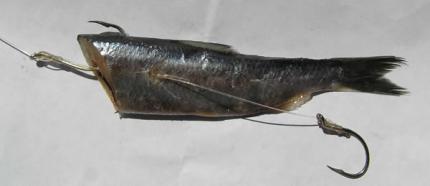
Jigs can be fished either vertically or horizontally. To fish vertically, let your line out to the desired depth, and raise and lower the jig continuously. You can vary the speed and distance that you jig, or even change after every 4 or 5 jigging motions. To fish horizontally, cast the jig out and let it sink however long you want. The longer you let it sink, the deeper it will go. When you reach your desired depth, pull the rod towards you; this causes the jig to rise. Then push the rod back in the direction of the jig and reel up any slack line; this causes the jig to fall. Pull towards you, push away and reel, pull and reel, etc, until you have retrieved the jig. The jig will be rising and falling all the way in on the retrieve.
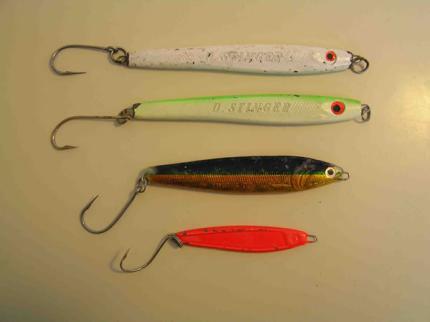
While jigs come in many sizes, shapes and colors, you can get started with just a few. Good colors to start with are chrome or white. Jigs weighing 2, 4, and 6 ounces will cover most of the fishing situations you might encounter.
Fly fishing
With the recent exploding interest in fly fishing there has been a growing interesting in chasing salmon in the salt with the fly rod. For years some of the most exciting fishing in Washington has been “bucktailing” during the mid-summer period on the outer straits. This entails trolling a skipping bucktail fly in the wake of the boat for the activity feeding coho. The fishery developed in the Neah Bay area during the latter part of the summer and entails trolling at a fast pace with the unweighted fly skipping near the boat in its wake. Traditional polar bear coho flies (in blue/white, green/white, chartreuse/white, etc) were used in this fishery (Photo 8).
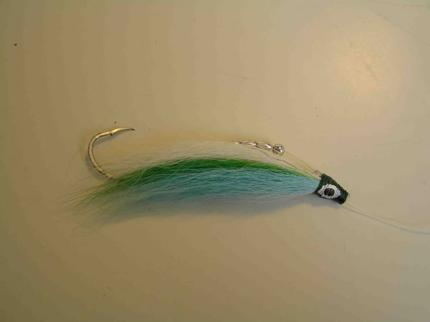
With improving fly lines, more and more anglers are looking to take salmon on cast flies. Coho salmon are the primary target for this fishing though Chinook, pinks, and chum can all be taken on the fly while they are in saltwater. Typically the actively feeding coho have offered the best chance for the fly angler to present their fly to the fish. The feeding coho that have chased one of the baitfish (herring, candle fish, etc) to the surface are the easiest fish to take. The observant angler should be able to detect this feeding activity by the wheeling birds, and splashes of the feeding salmon. Often this activity is along the various tide rips.
Successful flies include any of the bait fish imitating patterns with chartreuse and white, and pink and white being two popular colors. Fly size for these streamer type flies range from 2 to 5 inches in length. Many anglers opt to use weighed flies, often the “Clouser” type with lead "dumbbell" eyes. Flies with large heads and/or eyes often increase the effectiveness of the fly. Both floating and fast sinking lines are used depending on the feeding depth of the fish. Most anglers opt for fly rods in the 6 to 8 weight range equipped with reels that have decent drags.
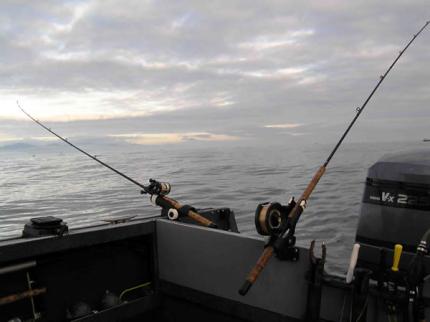
While the basic gear used for steelhead and other freshwater fish are perfectly serviceable in the salt waters of Puget Sound and the Strait of Juan de Fuca, it is important to remember to thoroughly rinse the gear with running freshwater after each day’s fishing.
Trolling
Trolling consists of fishing out of a constantly moving boat. Trollers will use weights, divers, or downriggers to achieve a desired depth to present their bait or lures. Trolling is more effective than drift fishing when salmon are spread out over a large area. Trolling with a downrigger is probably the most popular method of salmon fishing in saltwater in Washington.
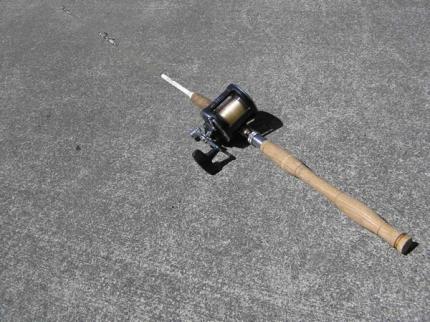
Motor mooching
Motor mooching is trolling with the same banana shaped weight and cut plug herring used by drift moochers (Photo 1). Most anglers fishing this way troll slowly with a plug-cut herring (Photo 2), although a few anglers will substitute a small spoon for the herring. Some anglers alternately put their motor into and out of gear to change depth and speed, and impart a different action to the bait. This is the simplest form of trolling and is cherished by folks that want to minimize the amount of gear needed and enjoy each fish caught.
Almost any type of rod and reel will work when trolling, as long as it is matched to the weight you are using (Photo 9). Historically, salmon anglers often used 6’ heavy fiberglass rods for trolling (Photo 10). Over the past 3 decades, lighter graphite rods have become more popular. An 8 ½ to 9 foot rod rated for 20-30 pound line and 2-6 ounce lures or weights would make a good choice. Most anglers prefer a quality level wind reel, but in a pinch you can get by with a heavy spinning reel. For trolling close to the surface, use 1 or 2 ounce sinkers. For trolling deep, use 3 to 8 ounce sinkers. You can also vary the depth you fish by the amount of line you let out. Many
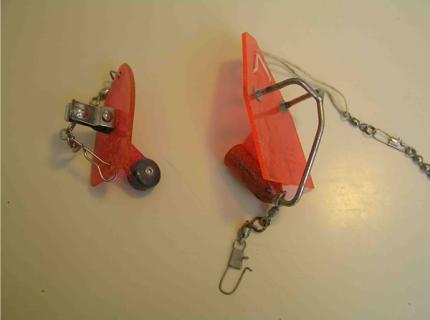
anglers count the amount of line they let out by the number of times they pull line off the reel up to the first guide on their rod. These are called “pulls” and can be used to either standardize all the baits to the same depth, or set out gear at different depths to find where the fish are. For example, a good combination for coho is 3 ounces of lead at 30 pulls. If you catch a fish at that depth combination, you will want to lower back to the same depth. If you aren’t catching fish, try adding or subtracting weight or letting out more or less pulls of line.
The standard 20-25 pound mainline works well for motor mooching, but you could also go down to 15 pound. Leaders in the 10-20 pound range all work well. Most anglers prefer a heavier leader for chinook and a lighter leader for coho. For chinook, fish close to kelp beds or other structures and troll slowly, less than 2 mph and close to the bottom. Start with blue or purple pack herring for chinook. For coho, find tide and/or current rips that concentrate bait and coho, and troll faster, 2-4 mph. Use green pack herring or smaller for coho, and stay near the surface.
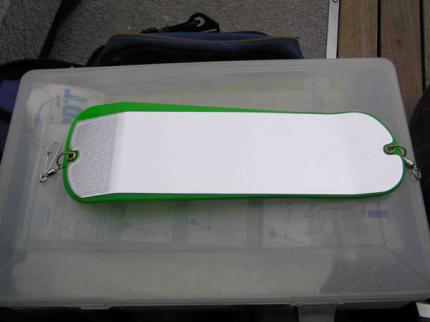
Divers
Trolling with a diver employs a stout rod with heavy line and a diving mechanism or diver (Photo 11) that takes the lure or bait to a specified depth. A diver can actually fish at depths up to 100’. When a fish strikes, the diver “trips” and stops diving. The tripped diver also does not pull as hard against the rod and you don’t have to fight it and the fish at the same time. Before downriggers became popular, divers were a common method that anglers used to fish deep. Divers are still used by folks that enjoy the simplicity of the gear or don’t have downriggers, or in certain situations were anglers feel that downriggers might spook the fish. For example, divers are still used extensively in the lower Columbia River (Buoy 10) during August and September. While a diver will get your gear down deep, they can put a tremendous strain on your rod, which is in part why historically salmon rods were short, heavy fiberglass rods. A quality graphite rod rated for 30-50 pound line will do the trick when fishing with divers. A lighter rod can be used, but the divers are very hard on them and the rod may not last very long. A quality level wind reel is again the reel of choice. Use 30-40 pound mainline to ensure you don’t lose your gear. Because you will be using heavier mainline than used in other types of trolling, you may need a reel with a larger line capacity.
Table 1. Recommended leader lengths between flasher and lure or bait
| Species | 8" Flasher - Hootchies | 8" Flasher - Lures or bait | 11" Flasher - Hootchies | 11" Flasher - Lures or bait |
|---|---|---|---|---|
| Chinook | 26" – 36" | 26" – 48" | 36" – 50" | 42" – 72" |
| Blackmouth | 20" – 24" | 20" – 36" | 20" – 34" | 20" – 56" |
| Coho | 22" – 30" | 22" – 48" | 26" – 40" | 24" – 42" |
| Pink | 18" – 24" | 18" – 36" | 27" | 42" |
Generally, anglers will use a diver with a dodger or flasher (Photo 12) and either a bait or lure (hardware). The old standby of a cut plug herring is always a good choice. Lures include hootchies, bucktails, spoons or plugs (Photos 13 - 16). Whether you decide to use bait or lures, you should generally rig all of your rods with the same type of gear to ensure that you are fishing each setup effectively. For example, it is very difficult to fish a cut plug herring on one rod and a spoon on the other, because the cut plug herring needs to be trolled at a much slower speed than the spoon. So try to stick with all bait or all hardware.
A plug cut herring or a spoon can be used without a dodger or flasher and the fish caught tend to fight better because they aren’t dragging the dodger/flasher through the water. However, if using a hootchie or bucktail, you must use a dodger or flasher to give the hootchie or bucktail action. The dodger or flasher causes the hootchie or bucktail to dart erratically from side to side. A dodger sways from side to side without rotating all the way around. A flasher rotates a full 360o. Adjust the boat speed to achieve the proper motion from the dodger or flasher. Fish with either dodgers or flashers, not both at the same time, because there isn’t a boat speed that is optimal for both. Use 40-60 pound leader between flashers or dodgers and hootchies or bucktails, as the heavy line will transmit more of the action from the dodger/flasher to the hootchie or bucktail than lighter line will. The length of leader between the flasher and lure is the subject of much debate. Each type of lure has a different leader length that it fishes best at, and different leader lengths seem to work better for each species of salmon. The following recommendations are just general guidance, don’t be afraid to experiment with different leader lengths.
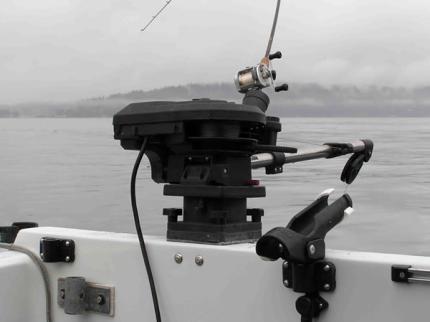
Downriggers
A downrigger is simply a large reel and boom with wire line that is used to lower a heavy lead ball to a specified depth. There are both manual and electric downriggers (Photos 17 and 18). A “release” mechanism (Photo 19) is used to
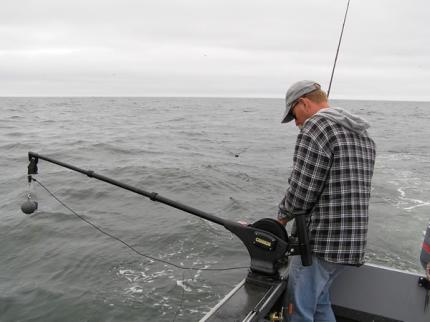
attach the fishing line to the lead “cannonball”. This mechanism releases the fishing line when a fish has been hooked, allowing the angler to fight the fish without the burden of heavy weights or divers. Using a downrigger to control the depth while trolling is probably the most popular method of saltwater salmon fishing today. When used in conjunction with a quality fish finder, the ability to put your gear at the exact depth that fish are at can be extremely effective. Secondarily, anglers can use lighter rods and still fish at great depths. The lighter rods allow you to enjoy the fight of the fish. A good downrigger rod generally is more limber than other salmon rods. Rods from 8 to 10 feet in length and rated for 12-30 pound line work well. Again, a quality level wind reel is superior for downrigger fishing. Your mainline should be 20-30 pounds. Leader weight and length depend on the type of lure or bait fished. Most downrigger anglers use a flasher or dodger, although they are not essential unless you are using a hootchie or bucktail. Behind the dodger/flasher, use either a cut plug herring, a spoon, a hootchie, or a bucktail as described in the diver section above. With the most common plastic flashers, put an 11” flasher 8’ to 20’ behind the downrigger ball, and put an 8” flasher 10’ to 20’ behind the ball.
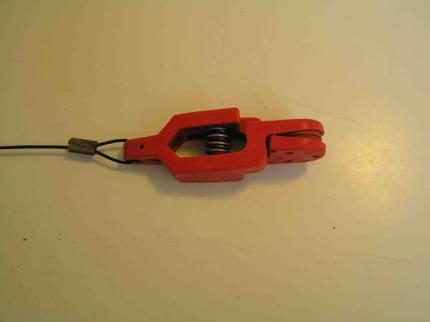
Fishing with downriggers requires a little more planning than other types of fishing. If you are fishing with more than one downrigger, you should fish them at depths that are at least 5’ apart to minimize the chance of tangling the lines on a turn. The deeper you fish, the more important it is to separate the lines. You should also pay close attention to the depth of the water, especially if the bottom is rocky or snaggy, and ensure that you are fishing above the bottom. You should only allow your cannonballs to hit the bottom in areas you know are sandy or silty. Retrieving a snagged 10-15 pound cannonball attached with 150 pound wire line can be very difficult and usually results in a lost cannonball, a broken wire, and lost fishing tackle. Finally, it may be helpful to install a stainless steel propeller guard (Photo 20) on your kicker motor (or your only motor if it is 25 horsepower of less). The guard will help prevent your downrigger wires and fishing lines from becoming tangled in the propeller.
Finding salmon
Knowing the habits of salmon is important for figuring out how to catch them. In general, each of the species can be found in the following areas:
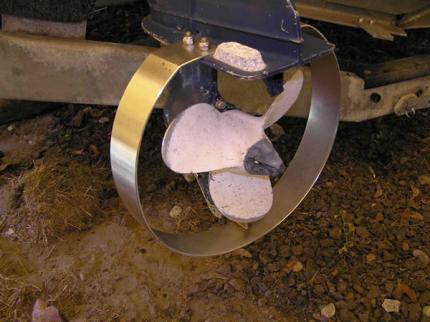
Chinook
Adult chinook salmon are usually found in two general habitats. Early in the morning or late in the evening, chinook can often be found cruising very close to shore, especially near kelp beds. At this time, they can be caught in 20’ to 120’ feet of water. They are most likely suspended in the water column, that is, they aren’t on
the bottom. In open water, chinook are going to be found were there is abundant bait. They can be anywhere from in the top 20’ of water to down on the bottom at depths of 200’ or deeper. Usually they will move deeper during the day as the sun gets brighter. A good starting depth for open water is between 40’ and 80’.
Blackmouth
Also known as “blackmouth” due to their dark gums, resident Chinook are a component of both hatchery and wild salmon runs that remain in the Salish Sea instead of migrating out into the ocean. Anglers may encounter juvenile or mature Chinook of various sizes and age classes, and these winter-caught salmon are known for being both aggressive feeders and delicious table fare. Other salmon species such as coho may also be encountered during this fishery and are legal to retain.
Typically fished in the winter and early-spring, blackmouth are generally found within 10’ of the bottom at depths between 60’ and 200’ feet of water. Occasionally they will be suspended, especially if there is lots of bait that is also suspended. They may also be sound in shallower areas where tidal currents congregate baitfish, especially in South Puget Sound.
Get tips on fishing for blackmouth and other species in the western Strait of Juan de Fuca in this March 2022 WDFW blog: More To Sekiu Than Chinook
Coho
The easiest way to find coho is to locate tide and/or current rips. These rips concentrate zooplankton and other invertebrates, which concentrate baitfish. Coho are often in the top 50’ of water, regardless of the time of day or weather, though bright sunshine can drive them deeper. While frequently found in open water, especially later in their migration, coho may also be found close to show and in surprisingly shallow water, especially if baitfish are present. Coho salmon are frequently caught by anglers casting from public beaches, especially points, at locations around Puget Sound.
Similar to blackmouth, resident coho spend their entire lives within the Salish Sea instead of migrating out to the ocean. Resident coho are widely distributed from British Columbia's Strait of Georgia to the Strait of Juan de Fuca and Puget Sound, though congregate in certain areas due to hatchery production or baitfish availability. Popular resident coho fisheries exist in the winter and spring in South Puget Sound (Marine Area 13), especially at the Tacoma Narrows, Fox Island and Purdy Bridge. And also in the early summer in Marine Area 10 and other locations as fishing regulations allow.
Pink
Pink are also an open water fish, but frequently come close to shore and even within casting range of public beaches. However, they are not necessarily associated with tide rips. They can often be found at depths of 40’ to 80’ below the surface but are not uncommonly caught deeper. Pinks travel together in large schools.
Sockeye
Marine Areas 5, 6, and 7 Sockeye Fishing Techniques (PDF)